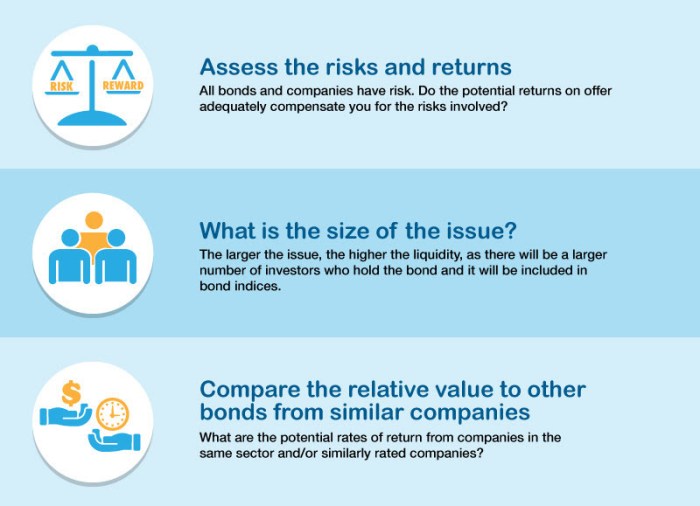Ready to dive into the world of bond investments? Buckle up as we take you on a thrilling ride through the ins and outs of investing in bonds. From understanding what bonds are to exploring different investment options, this guide has got you covered.
Get ready to become a bond investment pro with our step-by-step breakdown of how to navigate the bond market like a boss.
Understanding Bonds
In the world of investing, bonds are a type of fixed-income security issued by governments, municipalities, or corporations to raise capital. Unlike stocks, which represent ownership in a company, bonds are essentially loans made by investors to the issuer. In return, the issuer promises to pay back the initial investment amount (the principal) plus interest over a specified period of time.
Types of Bonds
- Treasury Bonds: Issued by the U.S. Department of the Treasury, considered one of the safest investments.
- Municipal Bonds: Issued by state or local governments to fund public projects like schools or infrastructure.
- Corporate Bonds: Issued by corporations to raise capital for various purposes.
- Savings Bonds: Offered by the U.S. government as a way for individuals to save money.
Risks and Benefits of Investing in Bonds
Investing in bonds comes with its own set of risks and benefits:
- Risks: Bond prices can fluctuate based on interest rates, credit quality, and market conditions. There is also the risk of default if the issuer fails to make interest or principal payments.
- Benefits: Bonds are generally considered less volatile than stocks, providing a steady income stream through interest payments. They can also act as a hedge against stock market fluctuations and offer diversification in an investment portfolio.
Factors to Consider Before Investing
When considering investing in bonds, there are several key factors to keep in mind to make informed decisions. Understanding how interest rates impact bond prices and returns, as well as the role of credit ratings, is crucial for successful bond investments.
Interest Rates Impact on Bond Prices and Returns
Interest rates play a significant role in determining bond prices and returns. When interest rates rise, bond prices typically fall, and vice versa. This is because newly issued bonds offer higher interest rates, making existing bonds with lower rates less attractive. As a result, bond prices adjust to remain competitive in the market. Investors need to be aware of these fluctuations and understand how they can affect the value of their bond investments.
Role of Credit Ratings in Bond Investment Decisions
Credit ratings provide valuable information about the creditworthiness of bond issuers. Bonds with higher credit ratings are considered less risky investments because they indicate a lower likelihood of default. On the other hand, bonds with lower credit ratings offer higher returns but come with increased risk. Investors must assess their risk tolerance and investment objectives to determine the appropriate balance between risk and return when selecting bonds based on credit ratings.
How to Invest in Bonds
Investing in bonds can be a great way to diversify your portfolio and earn steady income. Here are the steps involved in purchasing bonds and different ways to invest in bonds:
Purchasing Bonds
When purchasing bonds, you can buy them directly from the issuer or on the secondary market through a broker. Here are the steps to follow:
- Research and choose the type of bonds you want to invest in.
- Open a brokerage account if you don’t already have one.
- Determine the amount you want to invest.
- Place an order to buy the bonds either online or through your broker.
- Monitor your bond investments regularly.
Investing Through Mutual Funds or ETFs
Another way to invest in bonds is through mutual funds or exchange-traded funds (ETFs). These options offer diversification and professional management. Here are some popular online platforms or brokers where you can invest in bond mutual funds or ETFs:
| Platform/Broker | Types of Bonds Available |
|---|---|
| Fidelity Investments | Corporate, Municipal, Treasury Bonds |
| Vanguard | Government, Corporate, Municipal Bonds |
| Schwab | Corporate, Municipal, Treasury Bonds |
Building a Bond Portfolio

Investing in bonds can be a crucial part of a diversified investment strategy. Building a bond portfolio involves selecting a mix of bonds that align with your financial goals and risk tolerance.
Diversification of Bond Portfolio
Diversifying a bond portfolio is essential to reduce risk exposure and enhance potential returns. Here are some effective ways to diversify a bond portfolio:
- Invest in bonds with different maturities: Include a mix of short-term, intermediate-term, and long-term bonds to spread out risk.
- Consider various bond issuers: Invest in bonds issued by different entities such as governments, municipalities, corporations, and agencies to avoid concentration risk.
- Explore different bond types: Include a variety of bond types like government bonds, corporate bonds, municipal bonds, and high-yield bonds to diversify across sectors and credit qualities.
Risk Management Strategies
Managing risk in a bond portfolio is essential to protect your investments. Here are some strategies to manage risk effectively:
- Monitor interest rate risk: Understand how changes in interest rates can impact bond prices and adjust the duration of your bonds accordingly.
- Assess credit risk: Conduct thorough research on bond issuers’ credit quality to minimize the risk of default.
- Utilize bond funds: Consider investing in bond mutual funds or ETFs to access a diversified portfolio managed by professionals.
Optimizing Bond Portfolio
Optimizing your bond portfolio involves aligning your investments with your financial objectives. Here are some tips for optimizing a bond portfolio based on investment goals:
- Set clear investment objectives: Define your goals, time horizon, and risk tolerance to tailor your bond portfolio accordingly.
- Review and rebalance regularly: Monitor your portfolio performance and make adjustments as needed to maintain alignment with your investment objectives.
- Consider tax implications: Evaluate the tax consequences of your bond investments and optimize your portfolio structure to minimize tax liabilities.
